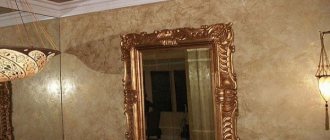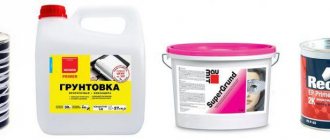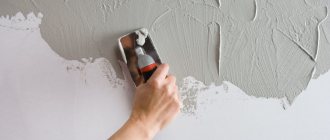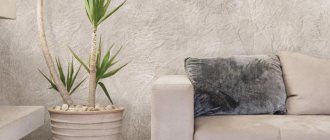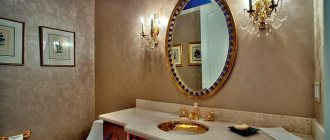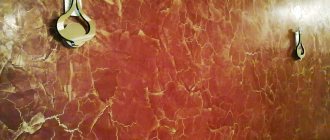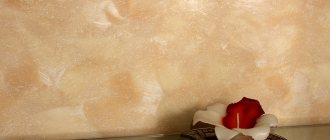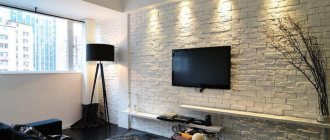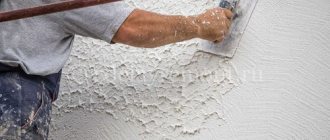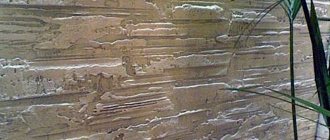On the domestic market, gouttelette decorative plaster is a rare and little-studied guest. This decorative material is not suitable for outdoor use, but it can be used indoors. Gouttelette can also be used in case of restoration or repair work. This is an excellent option for those who need simple decorative plaster at an affordable price.
The material can be applied to painted, plaster, concrete, plastered and wooden surfaces. It should only be used in dry rooms. The coating will be durable and resistant to friction. The matte surface will have a “spotty” texture, and a specific pattern can be created using various application techniques.
Gouttelette plaster – reviews
The decorative material gouttelette is little studied, and there are very few reviews about it. Here we have collected bits and pieces of reviews from all over the Internet.
I bought it at the Gouttelette store. I thought for a long time about what to choose from the cheap ones. I tried the solution on the wall, and after a day there was some not very pleasant smell from it. Then I saw that the product’s expiration date was already running out. I don’t know if this is due to this or if the unpleasant smell is due to something toxic in the composition. It's good that I didn't buy much.
Once I had a chance to work with an inexpensive “gutlet”. As they say, for every taste and budget. It is not much different from other plasters, except for the filler.
I bought this miracle product called Gouttelette. I decided to abandon wallpaper in the hallway in favor of plaster. I liked the result, although it immediately became clear that in some places it was necessary to putty better. The next day I decided to wash it with a wet cloth, but the coating softened and became deformed. Although by then it should have dried out. As I later found out, you shouldn’t rub gutlet with a wet rag because of its chalky base.
Textured plaster Maitre Deco “Le Beton” concrete effect 9 kg
Available for this plaster
In order to select and get a color code, use the Palette .
Order tinted plaster, indicating the color code you like in the delivery comments. Please note that ordering tinted plaster is only available with 100% prepayment.
Please also note that the color rendering on the screen of your device may differ from the actual color. For a more accurate color selection, please visit our stores.
LE BÉTON is a textured decorative coating with the effect of processed or, conversely, polished concrete.
Suitable for creating a wide variety of artistic effects. Suitable for application to almost any pre-prepared mineral base (concrete, concrete blocks, brickwork, cement, cement plaster, gypsum, gypsum plasterboards), as well as chipboard, fiberboard and other wooden surfaces.
Material properties:
- Made from environmentally friendly ingredients
- Visually smoothes the wall surface
- Warm to the touch
- The effect of decorative concrete in one layer
- Hides minor base defects
- Does not shrink
- Non-flammable, fire safety class KM1
- Certified for children's and medical institutions
Surface preparation:
Apply the material to a uniform, pre-leveled, dry and clean surface. If necessary, remove existing weak parts and loose layers of old paint with a spatula. Before application, protect unpainted areas with mounting tape or film. Treat the surface with AMORСE primer in one layer (consumption 0.1-0.2 l/m² on a smooth surface, drying time 2-3 hours) with a roller or brush to improve adhesion with subsequent layers of finishing materials, strengthening and removing dust from the surface. After complete drying, to color align the prepared surface, apply BASE QUARTZ primer paint (consumption 0.15-0.30 kg/m², drying time 6-12 hours) the resulting surface has a slight roughness. If necessary, after the first layer has completely dried, apply a second layer. Use a brush in hard-to-reach places
Application:
Before applying TRAVERTIN, carefully mix by hand. The material is ready for use. Application should begin from the upper left corner, moving to the lower right. To avoid noticeable seams on the surface, always work on a wet edge, leaving a minimum amount of material around the edges. To enhance the decorative effect, it is recommended to use the following materials as a finishing layer: EFFET MÉTALLISÉ, CIRE TEINTÉE, LAQUÉ MAT, LAQUÉ PERLÉ.
Drying: at an ambient temperature of +22°C and a relative air humidity of no more than 65%, permissible complete drying is 24 hours, wet cleaning no earlier than after 28 days. Drying time may vary depending on ambient temperature and humidity.
How to apply decorative plaster?
Application of a plaster mixture with decorative properties
Different types of decorative plaster are applied using different technologies, which is due to the different properties of the mixtures. However, some work (for example, preparing a surface for plastering) does not differ in technique and sequence. The only thing that is important to consider is that if small errors on the base are allowed for structural and textured compositions, then it is better to avoid the presence of errors before using the “Venetian”.
Surface preparation
One of the main and most important stages of plastering walls with decorative compounds is surface preparation. The process consists of high-quality removal of old finishing material, cleaning the base from contaminants, eliminating defects in the plastered surface or leveling plastering (if there are large deviations from the vertical or horizontal level).
Cleaning walls of old finishing material
Standard cement-sand and gypsum plasters are usually used to level walls and ceilings. When performing work in rooms with high humidity, as well as unheated utility rooms or outdoors, it is more advisable to use cement-based mixtures.
Leveling plastering technology:
- Initially, measurements are taken and the walls are marked in accordance with the existing deviations from the planes for the subsequent installation of beacons. For this purpose, a building level, plumb lines, tape measure and other measuring instruments are used.
Marking for installation of plaster beacons
- At the next stage, the thickness of the plaster layer is determined in places of maximum and minimum deviations, after which the average value is calculated and the required amount of leveling plaster is calculated.
- After purchasing the material, you can start working. Plastering begins with the installation of beacons, which are attached to portions of mortar previously sketched along the vertical marking line. The profile is laid on top of the mixture and, using a building level (to control the vertical position), is recessed into these “bulges”.
Installed beacons on brick walls
- The position of the plaster beacons can be adjusted until the applied portions of the solution set.
After installing all the beacons, you can begin leveling the surface of the walls. The solution is applied to the wall in the gap between the installed profiles by throwing - if the thickness of the leveling coating is more than 50 mm (the exact thickness per layer is written by the manufacturer on the bag), application is carried out in several stages (after preliminary setting of the previously applied layer). Then, using a rule, the sketched plaster is stretched along the beacons until a smooth surface is obtained. After hardening, it is advisable to perform priming.
Plastering walls along beacons
Tool for working with decorative plasters
Basic set of tools for working with decorative mixtures:
- Master OK;
- graters;
- ironer;
- putty knife.
When using a structural mixture, you may additionally need a specialized tool for structuring the surface - this includes special texture rollers, stencils and stamps with a variety of patterns and ornaments. But if you have experience and certain skills, you can use improvised means - a trowel, sponges, and other devices - to create an original relief surface.
Methods of applying decorative plaster: technology and basic techniques
If you will be using dry decorative plaster, you will need a construction mixer or drill with an appropriate attachment to prepare the solution. Mixing the mixture with water is carried out in strict accordance with the manufacturer's technological recommendations regarding the sequence of mixing actions and the proportions of the dry composition in relation to the liquid.
The application technology depends on the type of plaster used, but it is important to follow the manufacturer’s recommendations. General techniques for working with various types of mixtures:
- Textured materials are applied to the surface of the walls using a trowel or spatula. You need to work with small portions of the solution so that after application there is time to form the texture of the coating, which is done 15-20 minutes after application. Grouting is usually done with a trowel, and the technique of movement is determined by the composition used and the desired pattern.
Formation of a pattern when using a mixture of the “Bark Beetle” type
- Structural plasters are applied using a similar technology with textured compositions, only the pattern formation technique differs - a special tool or improvised means are used.
Application of different texture formation techniques using structural compositions
- Venetian compositions are applied in several layers - 1 base and 2-5 decorative. When applying the base layer, a small amount of the mixture is applied to the edge of the trowel or spatula with a trowel, which is rubbed into the surface in one free arc-shaped movement. In this case, each subsequent strokes should overlap the previous ones by approximately 5-10 mm. Subsequent layers are applied with long and short strokes. The uniformity of application does not matter, since it is the randomness of the strokes that creates the original texture. The last layer is glaze and is applied in small squares (about 1 m2 in area). After preliminary setting of the square, the coating is polished with a clean metal float or spatula until a light gloss is obtained.
The process of applying Venetian plaster
Below are several videos with techniques for applying different types of plaster mixtures:
- Venetian:
- structural:
- textured type “Lamb”:
